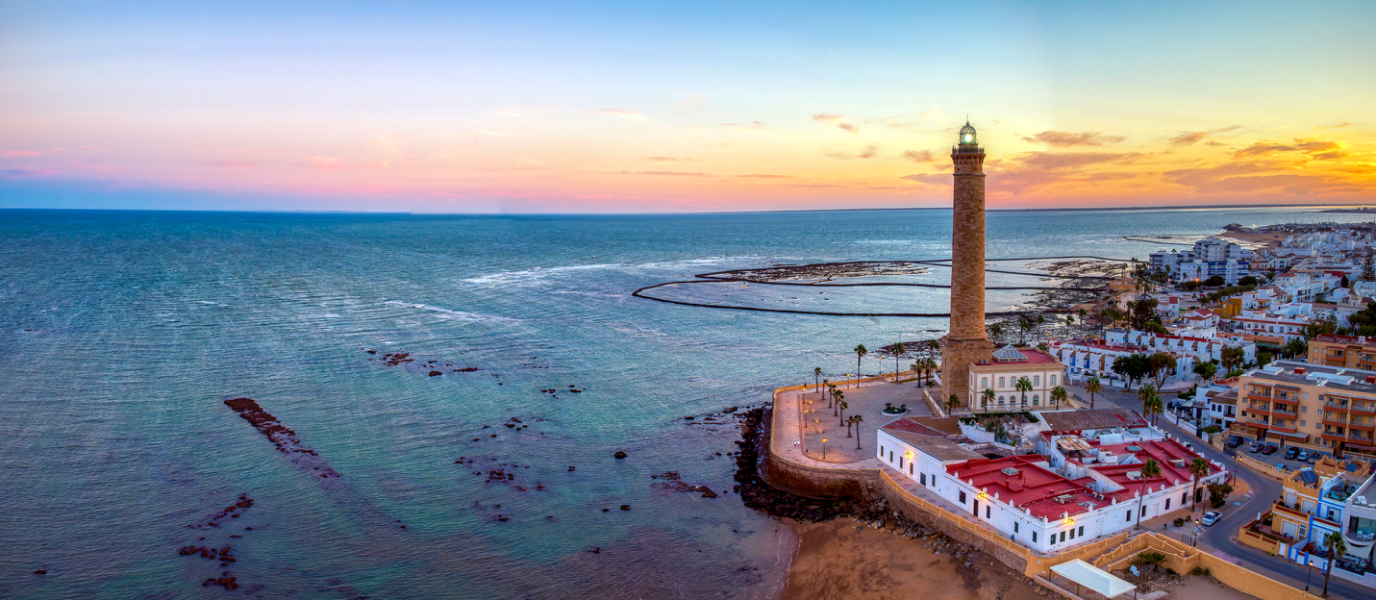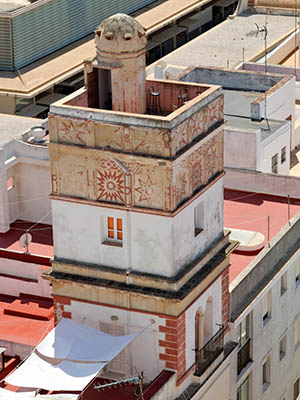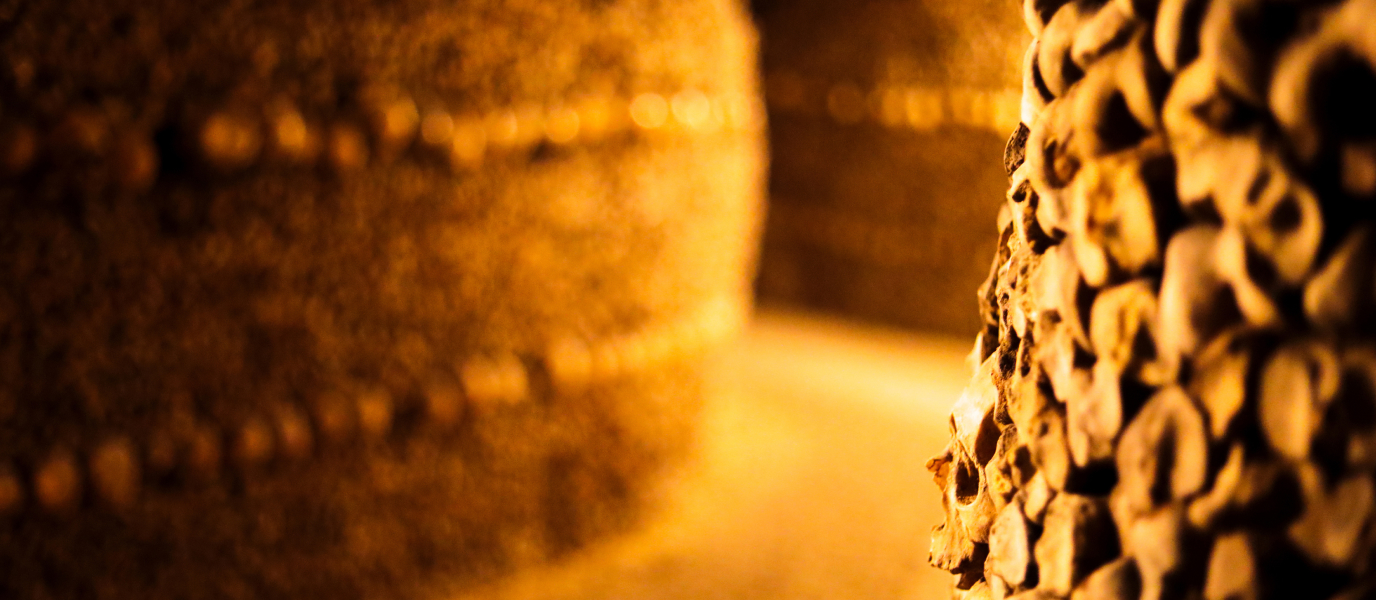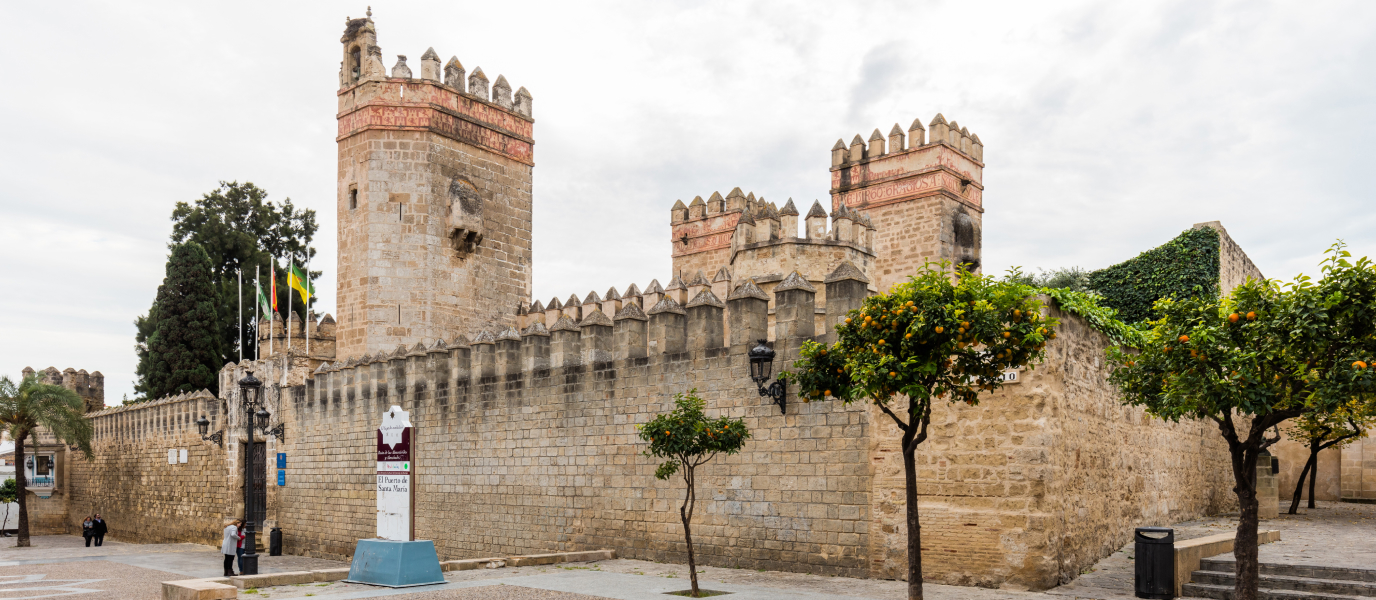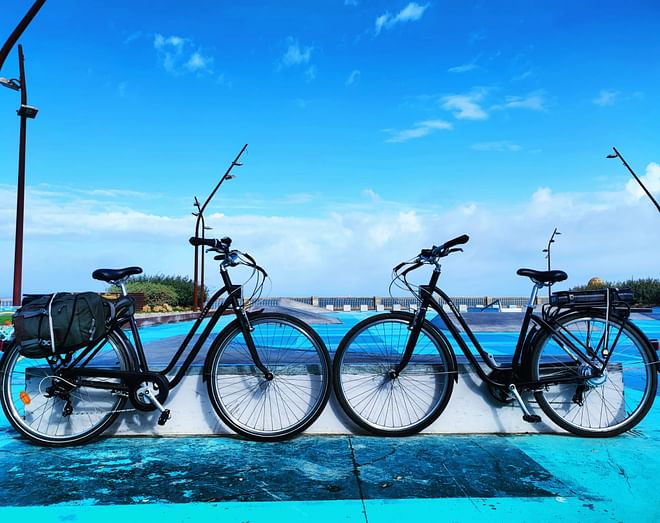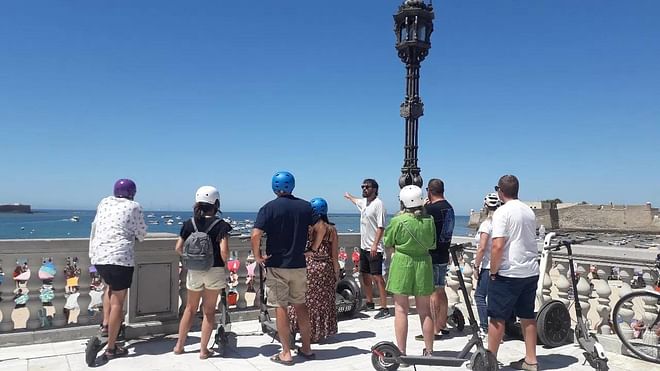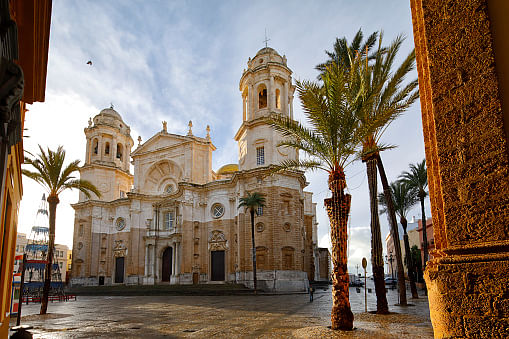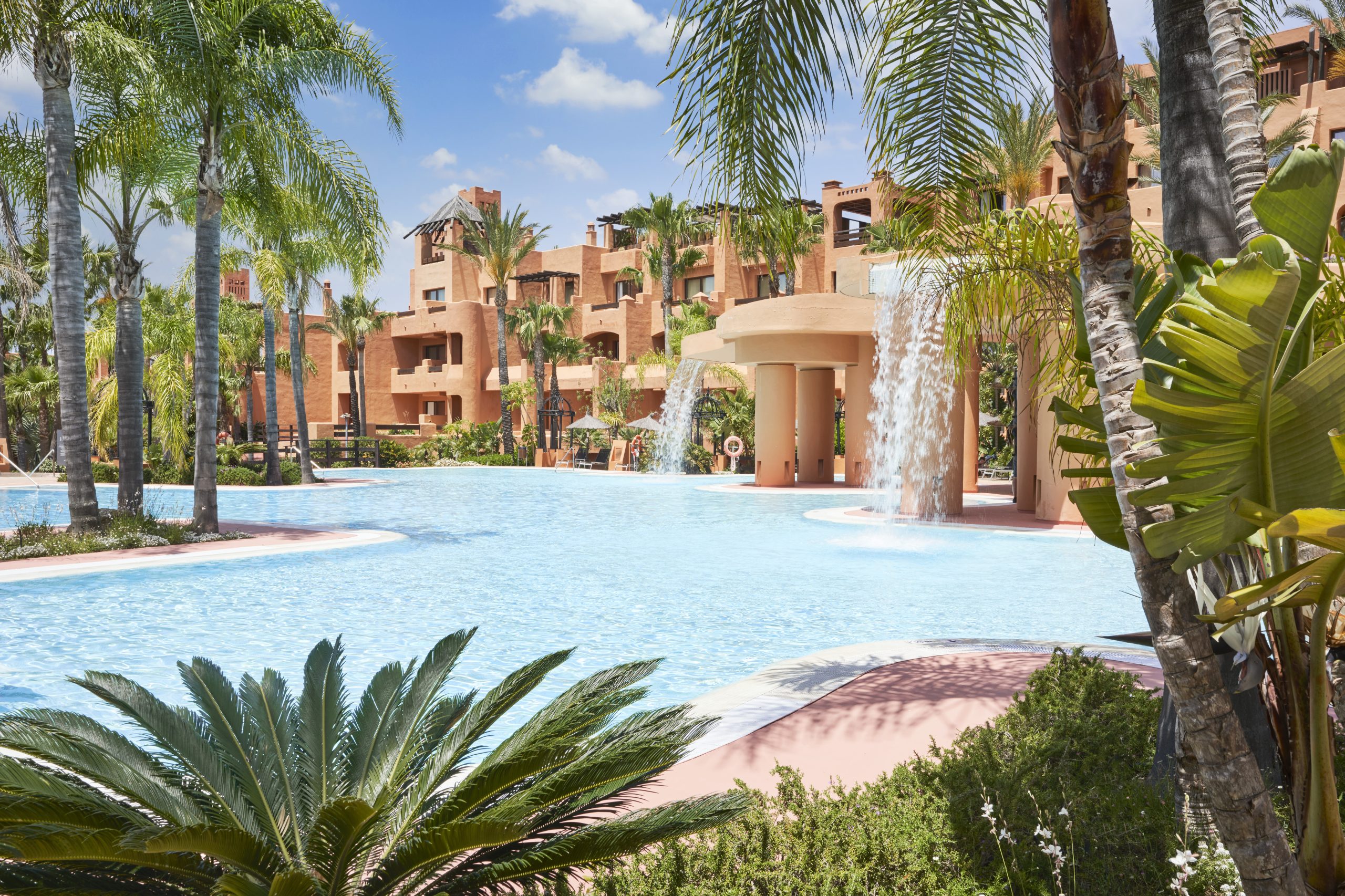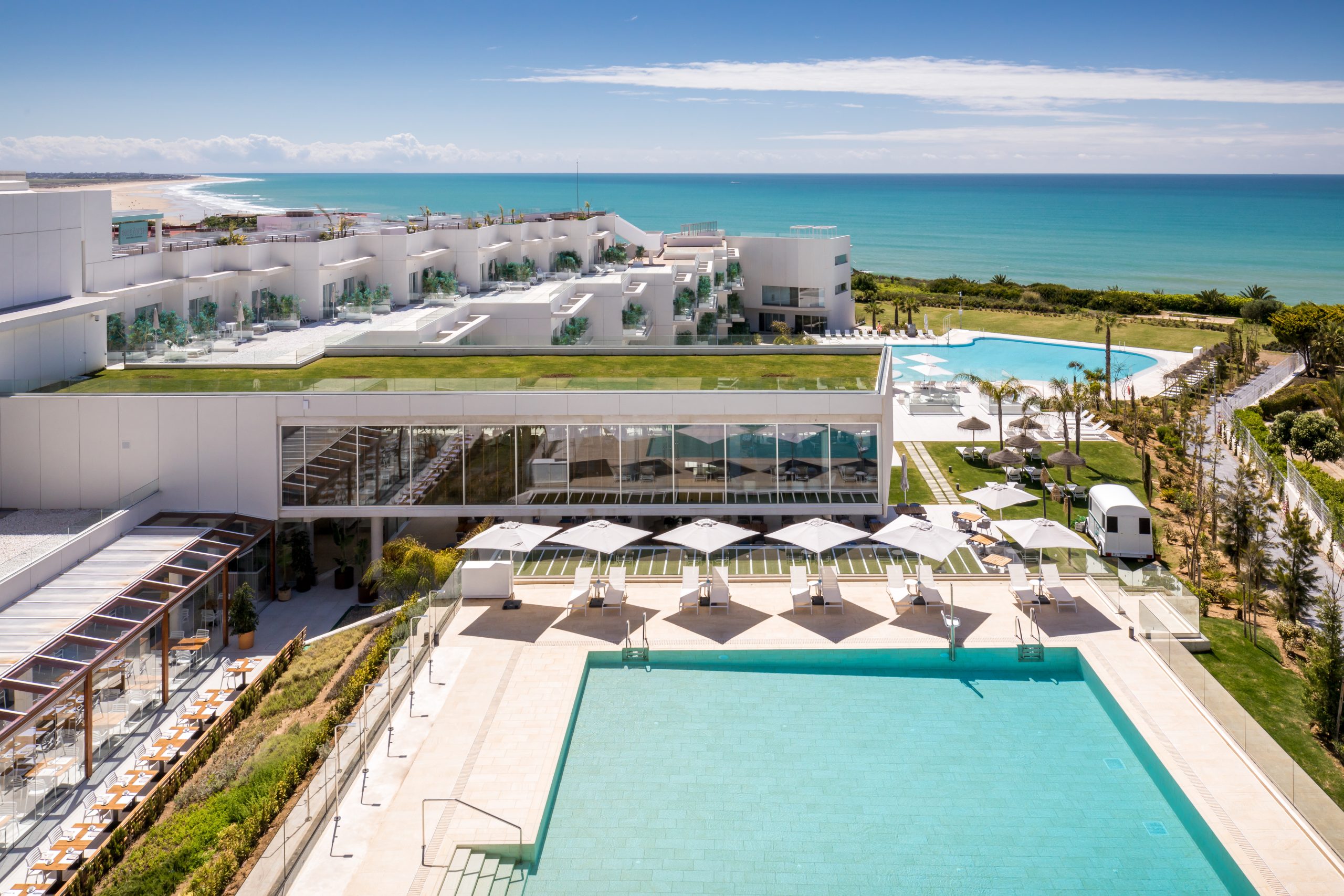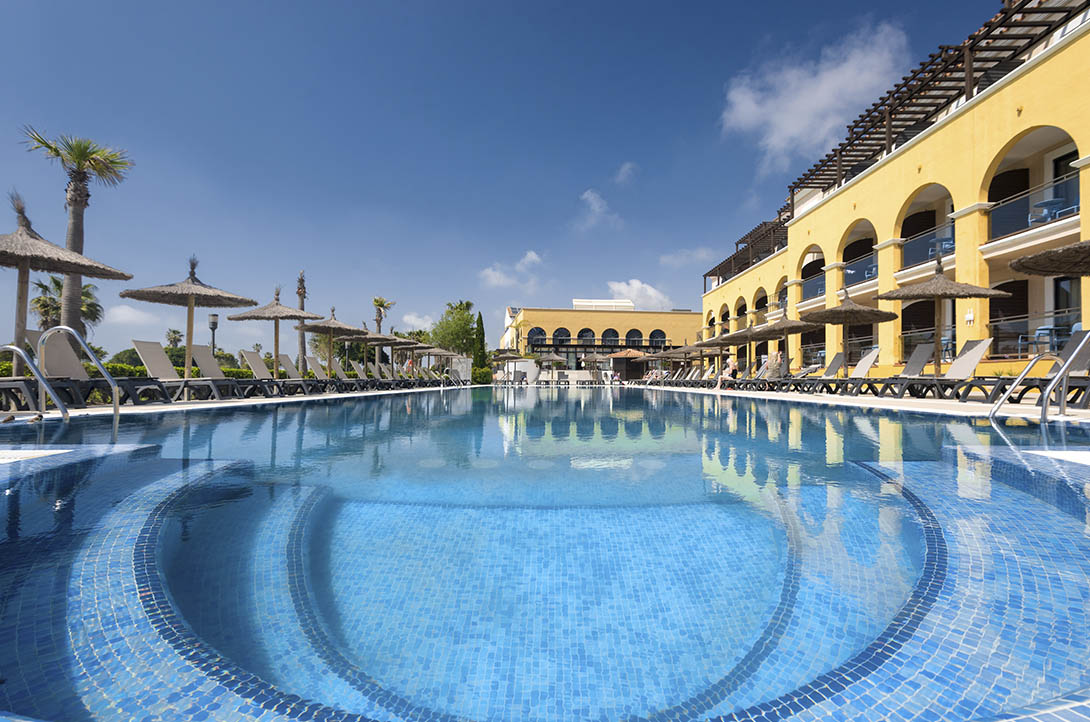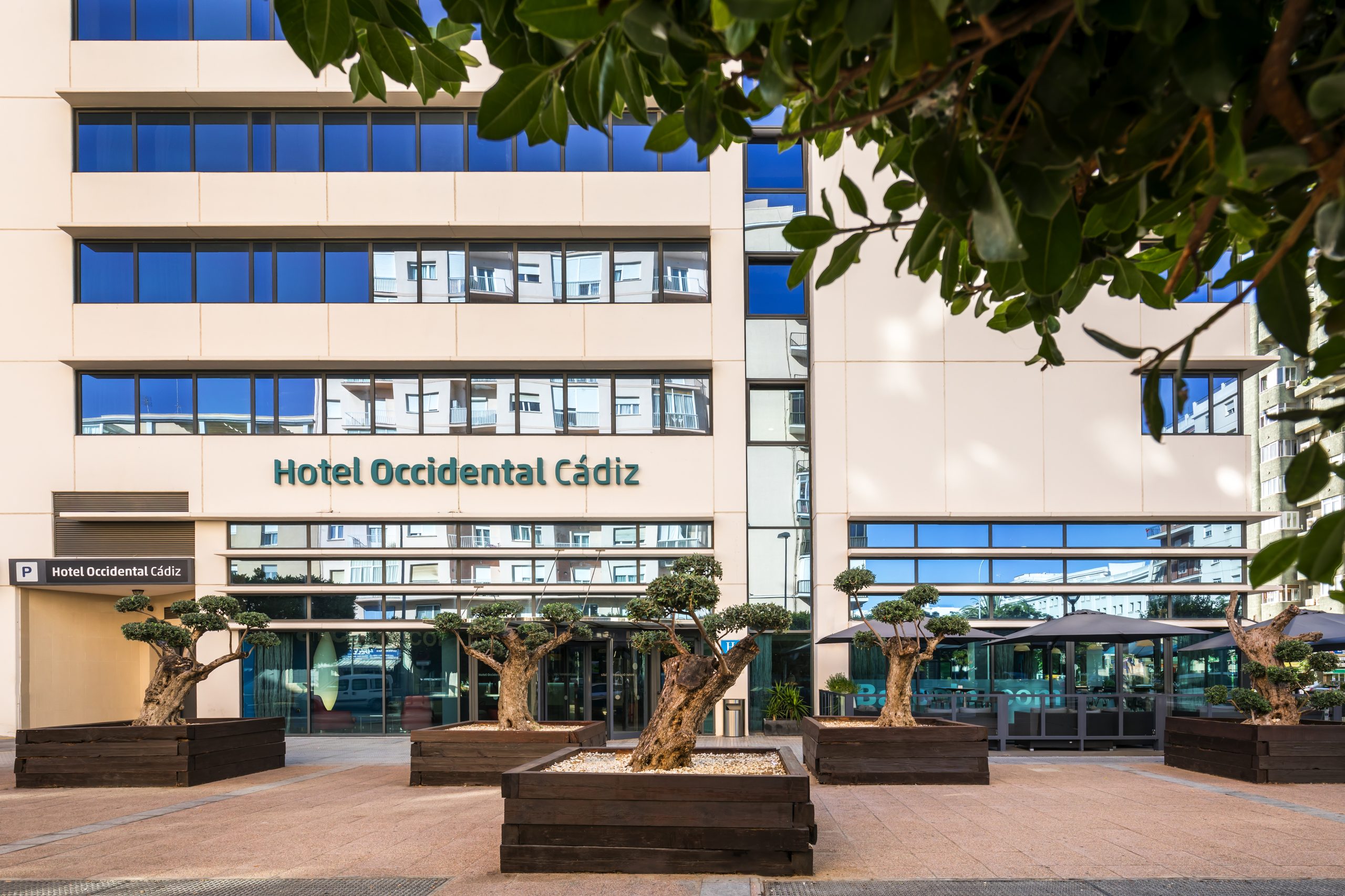Beautiful Cadiz is the oldest city in Western Europe. Its strategic southern location has made it a sought-after spot by different cultures for centuries and the Phoenicians, Greeks, Romans and Arabs all walked its streets.
And the city is full of urban heritage, with important civil and religious monuments. It also has a wide range of cultural activities with something for everyone, and the sense of joy felt in every corner of the city is matched by its magnificent food. Just like Malaga, Huelva and Almería, Cadiz province has a seemingly infinite number of fun activities and attractions to enjoy.
You’ll be swept up by the enticing sea, scents, music and unbeatable charm of Cadiz.
Find out everything there is to do in Cadiz so you don’t miss a thing on your trip.
- What to see in Cadiz, the provincial capital
- What to visit in Cadiz province
- The most beautiful beaches in Cadiz
UNMISSABLE SIGHTS IN THE CITY OF CADIZ
El Pópulo neighbourhood, the heart of Cadiz
The north of Cadiz is home to one of the most important neighbourhoods in the historic centre: El Pópulo neighbourhood. It’s the oldest in the city and is found in the area that was once surrounded by the city walls. Its most important monuments are the cathedral and Roman theatre.
The three entrance arches date from the 13th century. The best way to see the neighbourhood is to wander aimlessly among its narrow, cobbled streets, where you’ll find plenty of shops selling hand-crafted goods if you’d like to pick up some souvenirs.
Visit the Casa del Almirante [House of the Admiral], a lovely Baroque palace, and don’t miss the lively vibe on weekends when the outdoor terraces fill with people and you can experience the true spirit of Cadiz, particularly at night. And don’t leave without trying delicious tapas at bars like Tapería La Tramposa with its wonderful “papas aliñás” [potatoes in dressing] and cazón en adobo [marinated dogfish].
Cadiz Cathedral: 18th century splendour
Cadiz Cathedral is the city’s great religious masterpiece. The old 16th century cathedral is now a parish church and was replaced by the cathedral in use today, which is one of the most outstanding monuments in Cadiz, located right by the sea and visible from almost everywhere in the city. The building is a unique combination of the Baroque, Rococo and Neo-Classical styles.
It clearly exemplifies the rich era in which it was built, when the city’s wealth was generated by trade with the Indies. Don’t miss its portico, which is flanked by two towers, and its play of concave and convex volumes. When you step inside, you’ll be surprised by the building’s different domes. Climb the clock tower to enjoy fantastic views of El Pópulo neighbourhood and the port.
The cathedral contains several interesting curiosities, including the tomb of Miguel de Falla, and Christian holy relics such as a fragment of the True Cross, and a thorn from the crown of thorns. The Cathedral Museum also houses the table on which ‘la Pepa’, the 1812 Constitution, was signed. Cadiz Cathedral is the perfect departure point for a walk around the historic centre.
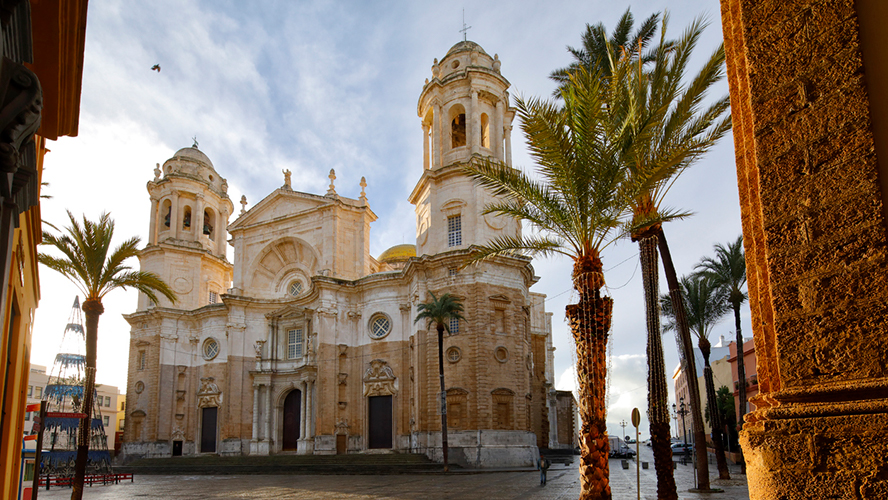
The Roman theatre, a ticket to the past
Cadiz enjoyed a golden period under Roman rule; it was renamed Gades and a Roman circus, aqueducts and temples were built here. One of the most superb remains from the period is Cadiz’s Roman theatre, which was discovered in 1980.
It’s the second largest Roman theatre in Spain and the oldest conserved today. Thanks to archaeological work, a large part of the stands, the orchestra and a circular gallery have now been uncovered.
An interpretation centre has been created for other parts that haven’t yet been unearthed, while remains of the theatre’s elaborate decoration can be seen in Cadiz Museum. The theatre could hold up to 10,000 people. It’s an exceptional example of Spain’s Roman past and after your free visit, you can carry on your walk around El Pópulo neighbourhood, visiting the church of Santa Cruz or lively Plaza de San Juan de Dios.
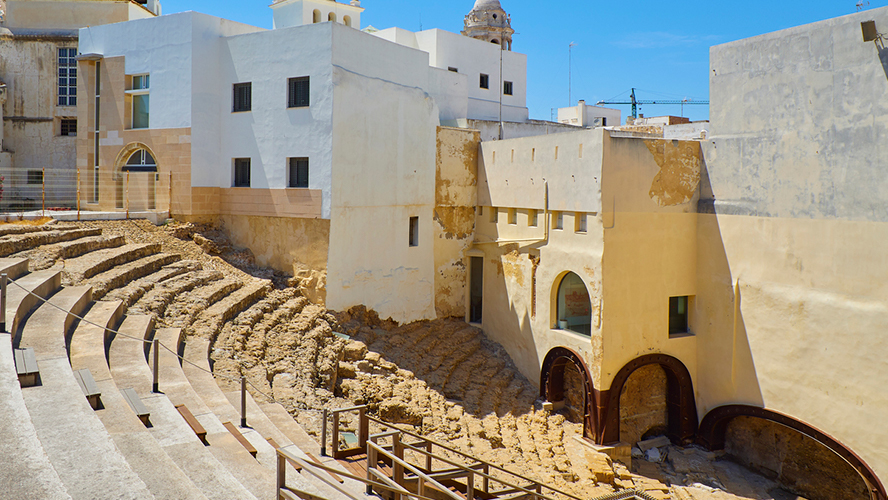
The Teatro Falla, “the house of the blushing bricks”
This is the loving name Cadiz locals have given the Teatro Falla thanks to the unusual reddish colour of its façade. The theatre is in El Mentidero neighbourhood, where you can also see other buildings such as the Casa de las Viudas [House of the Widows]. The Teatro Falla is a wonderful example of the Neo-Mudejar style and is a fin de siècle jewel that stands where the Gran Teatro de Cádiz was once found. It’s the number one stage for the city’s popular carnival each February, but is also used for all kinds of plays, music, dance and opera.
It’s a luxurious, colourful space: climb to the top floor to get a close up look at the beautiful frescoes on the ceiling. Its horse-shoe shaped interior can seat around 1,200 spectators. Check the programme to see what’s on: there are big shows with something for everyone, but carnival tickets are definitely the most highly prized.
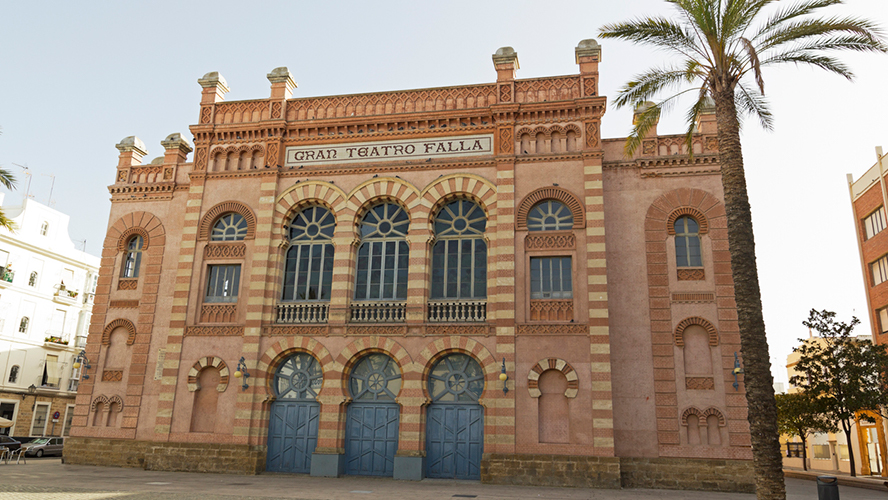
Tavira Tower: a window over the city
Cadiz is full of watchtowers and over 100 of the 160 that once existed still remain. They were used to watch over traders arriving at the port when the Casa de Contratación de las Indias was moved to the city.
Tavira Tower is part of the House-Palace of Los Marqueses de Recaño and has become one of the most attractive places to visit in the city. You can enjoy a bird’s eye view of the whole of Cadiz from the tower and it’s the best viewpoint in the city. Look out for the isthmus that joins Cadiz to the mainland, the towns along the bay, the beaches and, of course, the monuments and famous white-washed houses. Don’t miss the Camera Oscura in the tower, a system of mirrors on the flat roof that reflect onto a cone-shaped screen to display life in different parts of the city in real time.
Plaza de España, a tribute to history
Plaza de España is an iconic place in Cadiz, the ‘tacita de plata’ [little silver cup], and this square is home to several important buildings. There’s lots to discover here so you’ll have to explore it carefully to see all of its monuments. It was designed to commemorate the first centenary of the 1812 Constitution.
It’s surrounded by gardens, and the Monument to the 1812 Constitution is the centrepiece. The site couldn’t be better, because ‘la Pepa’ was signed on 19 March 1812 in Cadiz. It was a milestone in Spanish history and the event is commemorated here with an open semi-circle that looks out to sea and has a full iconographic scheme.
The square is also home to the Casa de las Cinco Torres [House of the Five Towers], an example of Cadiz’s late Baroque, and the old Customs House, today the Palacio de la Diputación [Palace of the Regional Government], a Neo-Classical building. It’s the perfect place to carry on with your day of tourism and it ends in beautiful Plaza de las Flores, where you can sample typical dishes of fried fish.
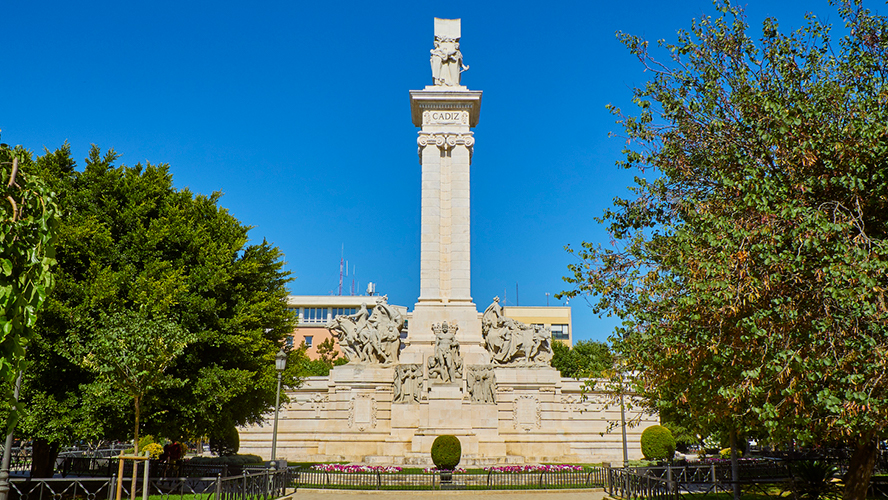
La Viña: tradition and the scent of the sea
This picturesque neighbourhood is framed by La Caleta beach, the only beach in the city centre and the most famous. It was given the name ‘Viña’ because vines were grown here in the past; located far from the port, the neighbourhood was inhabited by working class people whose main source of food was fishing. One of its major landmarks is the castle of San Sebastian, an 18th century fortress where you can enjoy magnificent sunsets if you’re looking for a romantic experience.
The carnival starts in La Viña each year and the streets fill with joy and music. It’s the best place to try fish and seafood as you experience the highly original spirit of Cadiz. Stroll down La Palma street where you’ll find plenty of tapas bars and flamenco bars.
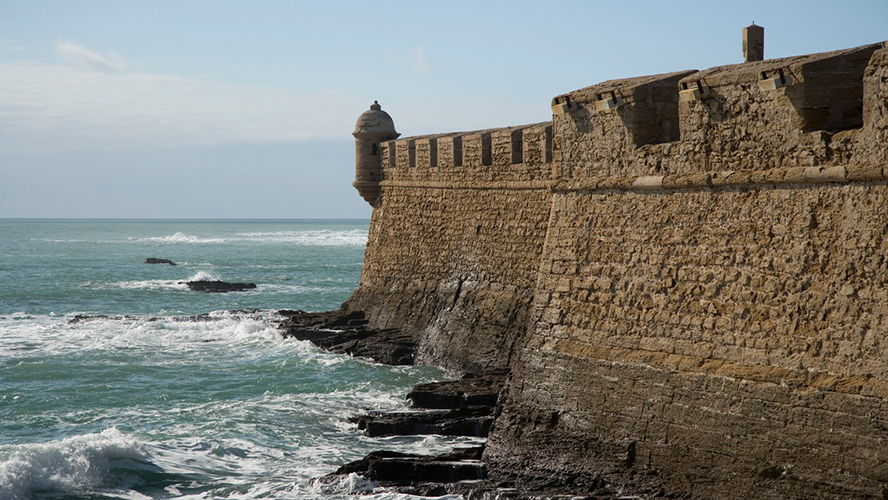
La Caleta, Cadiz’s beach par excellence
It may not be the only beach in the city but it’s definitely the most attractive. It also has a long history – boats were moored here in Phoenician times.
La Caleta is framed by the two most famous fortifications in Cadiz: the castle of San Sebastian and the castle of Santa Catalina. The castle of San Sebastian has a lighthouse that illuminates the beach and part of La Viña neighbourhood at night.
One of the most eye-catching buildings is the spa of Nuestra Señora de la Palma y del Real, a stunning early 20th century building that lines the beach. People playing games of bingo is a typical sight here in the afternoons. La Caleta is meeting place for swimming and relaxing, and is a good excuse to visit popular bars such as Quilla and Casa Manteca for an aperitif.
You can get there by car, bus or, best of all, on foot; it’s only a 15- minute walk from the cathedral.
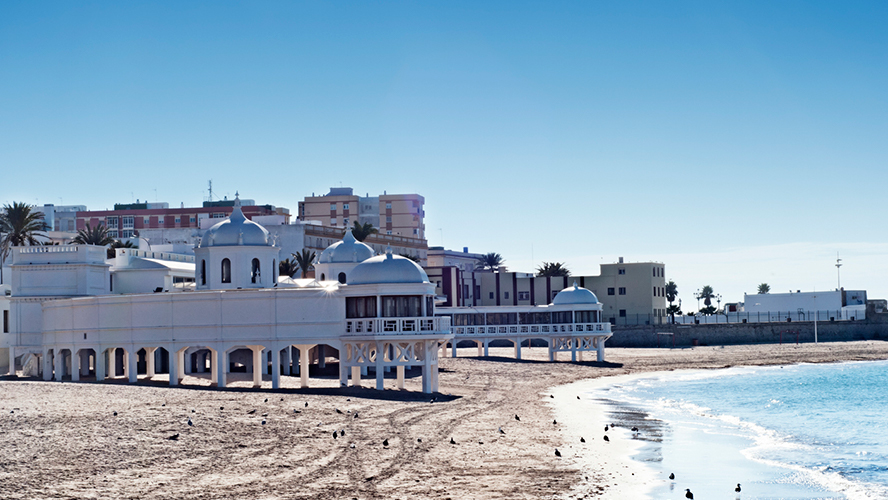
La Victoria beach: a holiday destination in itself
Together with La Caleta and Santa María beaches, La Victoria is another of Cadiz’s great city beaches. Here you’ll find the largest number of bars, beach bars, restaurants and hotels along more than three kilometres of sand.
It’s been named one of the best city beaches in Europe and normally has blue flag status. Unlike La Caleta, which is closely linked to local neighbourhood life, La Victoria is a big draw for tourists. It’s the perfect spot for sunbathing, doing sports like beach volleyball, or going for a long walk.
Don’t miss the sunset from here with the cathedral in the background. The beach extends into Cortadura beach, a practically unspoilt stretch of sand that runs on for almost four kilometres and is far more peaceful. Try the creative cooking of Arsenio Manila or visit lively beach bar Bebo los Vientos. You can get here easily by car or bus along the beachfront promenade.
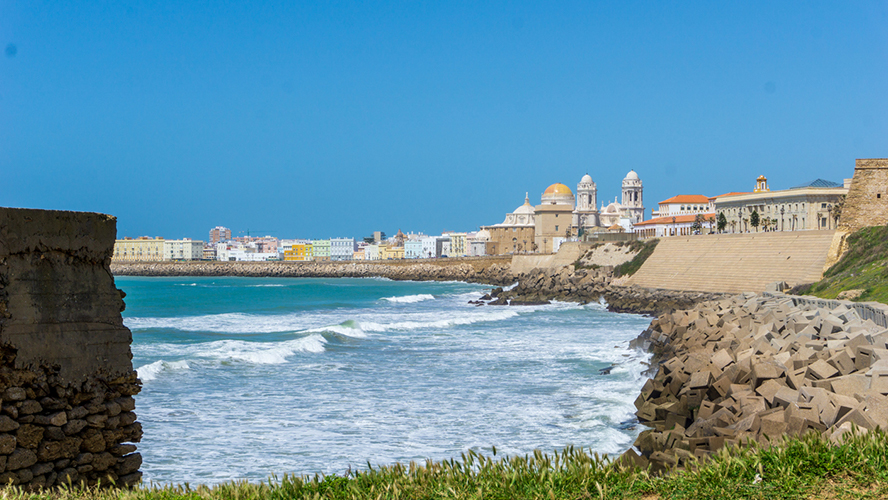
Castle of Santa Catalina: the oldest fortress in Cadiz
The castle of Santa Catalina is an Asset of Cultural Interest and is the oldest military structure in the city. The unusual three-pointed star shape on its sea-facing side is one of its most distinctive features. The part on land forms a pentagon and construction began at the end of the 16th century.
Don’t forget your camera to capture the incredible sea views. And make the most of your visit to discover the castle’s history, for example, it was also used as a prison until the end of the 20th century. Today it’s a cultural space and holds temporary exhibitions, and film and music festivals.
The castle of Santa Catalina is at one of the far ends of La Caleta beach and can easily be reached on foot, taking in other defensive structures along the way, such as the bastion of Los Martires and the castle of San Sebastián.
The Paseo Marítimo in Cadiz: made for walking
Cyclists and pedestrians have priority on the Paseo Marítimo thanks to the new bike lane that has almost entirely stopped vehicles from circulating here. Cycling along the bike lane to discover the city and explore its different beaches, such as La Victoria and Cortadura, is a fantastic way to spend the day.
You can stop off for a drink or bite to eat at one of the many terraces with sea views that you’ll find along your ride. Get a sense of the spirit of Cadiz as you watch people strolling along the Paseo Marítimo.
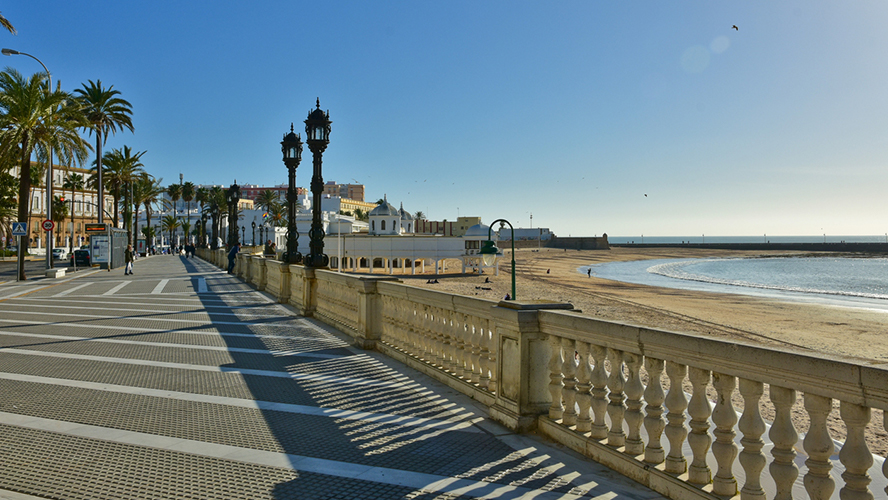
El Parque Genovés, a historic garden by the sea
If you’d like to go for a pleasant stroll, lovely Parque Genovés next to the historic centre is waiting for you – it’s one of the most popular parks in the city. It’s the perfect place to wind down after a busy day of tourism.
Its origins can be traced back to the 18th century but the park has been expanded several times in recent years. Walking down its main cypress-lined avenue is the ideal start to a romantic evening. It has more than a hundred different species of trees and a monument to Félix Rodríguez de la Fuente. Discovering the park’s hidden spots to the sound of the sea is an utter delight.
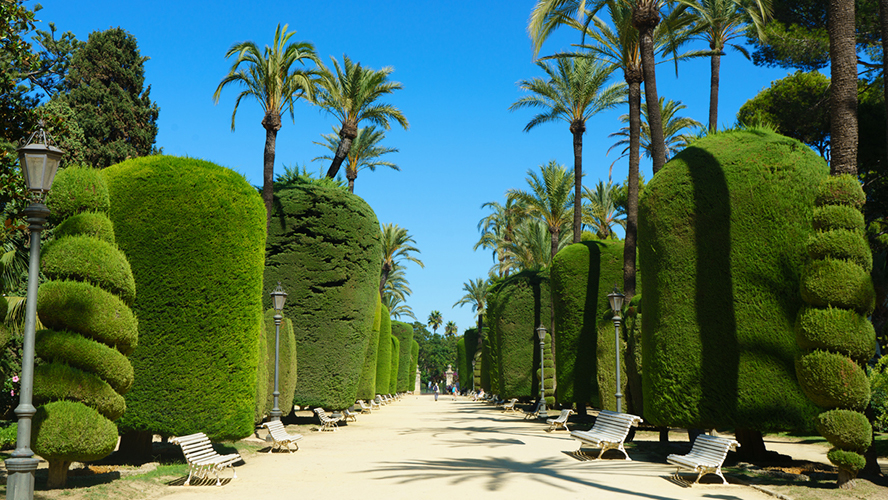
Archaeological site of Gadir
One of the most fascinating activities you can do in a thousand-year-old city like Cadiz is visit some of its historical remains, which give you a clue of what society was like here in the past and an insight into its economic activity. When you visit the archaeological site of Gadir, in the heart of Cadiz, you’ll discover interesting facts about Phoenician culture. The space open to visitors is spread across different levels that show the various periods when the site was in use and you can see the town layout, ancient homes and even tools from 9th century BC. The visit is constructed around the figure of Mattan, a Phoenician who died in a fire in 6th century BC, and his life story is part of the itinerary.
The catacombs of El Beaterio
This is one of the most original places to visit in the city of Cadiz. Also known as the Low Pantheon, the catacombs of El Beaterio were the burial place of members of the Third Order of St Francis in the 18th century. The sanctum was founded by María José Isabel and twelve nuns lived here who pledged obedience to the head sister. The complex consisted of a chapel, sacristy, choir and the Low Pantheon. After several tumultuous periods of history that saw the confiscation of ecclesiastical property and a civil war, the area was cleaned and these important remains were rescued for study and public visits. If you’d like to visit the catacombs, head to number 3, Calle Valverde; don’t forget to book in advance.
Trafalgar Lighthouse, a view into the past
Trafalgar Lighthouse is an essential stop on your visit to Cadiz thanks to its history and spectacular setting. It’s on Caños de Meca beach, on the outskirts of Barbate and stands 40 m high. It’s kept a watchful eye on the coast since 1860, making it the second oldest lighthouse in Spain. The interior isn’t open to the public but you can get very close to its base and from this spot you’ll enjoy the most spectacular sunsets in the area.
Before it was built, this was where the Battle of Trafalgar (1805) took place, when the Spanish and French fleets battled and lost to famous Admiral Nelson. Over five thousand people died in just six hours of battle, without counting the large number who were injured. Shipwrecks from the period can still be seen on the seabed. Make the most of your visit to Trafalgar Lighthouse to go scuba diving and enjoy the surrounding beaches: Mari Sucia, El Faro and Caños de Meca.
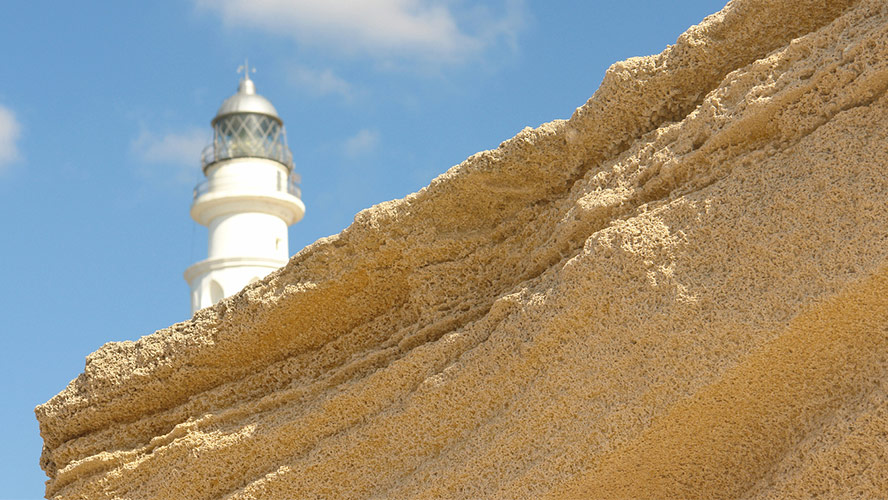
Baelo Claudia
The ancient Roman city of Baelo Claudia stood by the sea, next to Bolonia beach, the perfect location for people who were constantly using the sea for trade. Today it’s a wonderful place to stroll around, after visiting the interpretation centre, to see streets marked by easily recognisable structures such as the basilica, temples, the theatre and the thermal baths. The remains of Roman salting factories are particularly fascinating; they were used to prepare tuna caught on the coast that was then sent to other cities in the great Roman Empire.
This site is 22 km from Tarifa, making it the perfect day out from any point along Cadiz’s coastline. Make the most of your trip and head to Bolonia beach afterwards, which has an impressive dune that has been made a Natural Monument. Climbing to the top is worth the struggle to enjoy stunning views of the area.
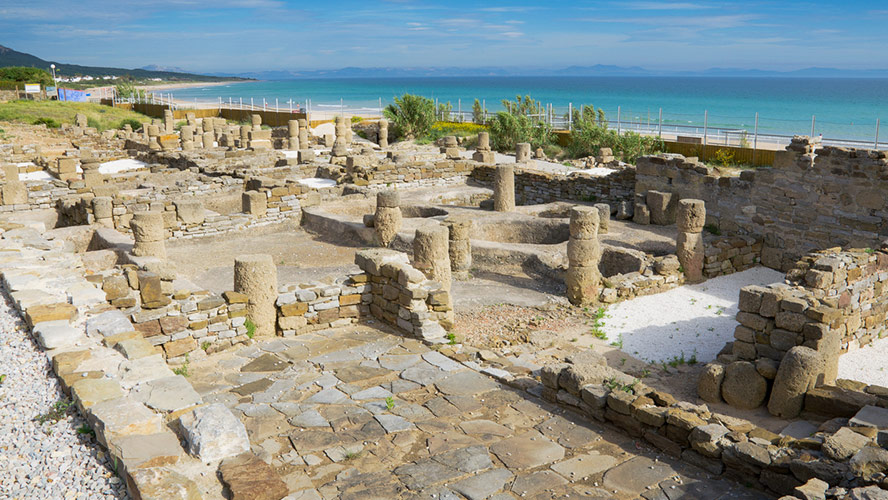
UNMISSABLE TOWNS IN CADIZ PROVINCE
Puerto de Santa María
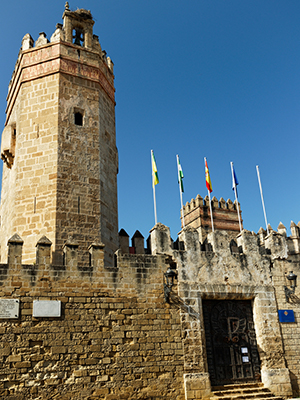
This town in Cadiz province has plenty to offer travellers with a historic centre, beaches, wineries and restaurants. Essential stops in El Puerto de Santa María include the castle of San Marcos, where Christopher Columbus once stayed; the church of Mayor Prioral, with a beautiful stone façade; and the monastery of La Victoria, where the cloister was once used as a prison.
If you visit in summer, you’ll have plenty of fun at the glamorous marina, Puerto Sherry, and on its beautiful beaches. The longest, most tourist-orientated beach is Valdelagrana, but it’s worth exploring others such as La Puntilla, next to the Guadalete estuary; La Muralla, next to Puerto Sherry; Vistahermosa, next to the urban development of the same name: and Fuertebravia, which borders Rota naval base.
And in terms of wine and food, we recommend visiting Bodegas Osborne, and trying food by renowned chef Ángel León at A Poniente. The town is also packed with restaurants where you can enjoy delicious food at reasonable prices.
Jerez de la Frontera
The stately city of Jerez de la Frontera never disappoints with its decorated churches, numerous small palaces and the fantastic atmosphere of its traditional bars. It’s also famous around the world for its ‘dancing’ Andalusian horse shows and motor racing circuit.
We recommend starting by visiting its heritage, such as: the Alcázar, Jerez Cathedral, the church of San Miguel, the old Casa del Cabildo and Plaza del Arenal.
Secondly, in a city where wineries are a veritable institution, you simply have to visit a couple to learn something about this culture and sample its finest wines. Great wineries include Tío Pepe-González Byass, Sandeman, Fundador Pedro Domeq-Harveys and Lustau, among others.
Finally, don’t leave Jerez de la Frontera without discovering its tabancos, traditional bars that used to serve wine and are now places where you can enjoy tapas and listen to flamenco.
If you’re visiting with your family, make time for a trip to the Zoobotánico de Jerez, a zoo and botanical gardens, and Ciudad de los Niños, which has flying foxes, trampolines etc. Both excursions are guaranteed fun!
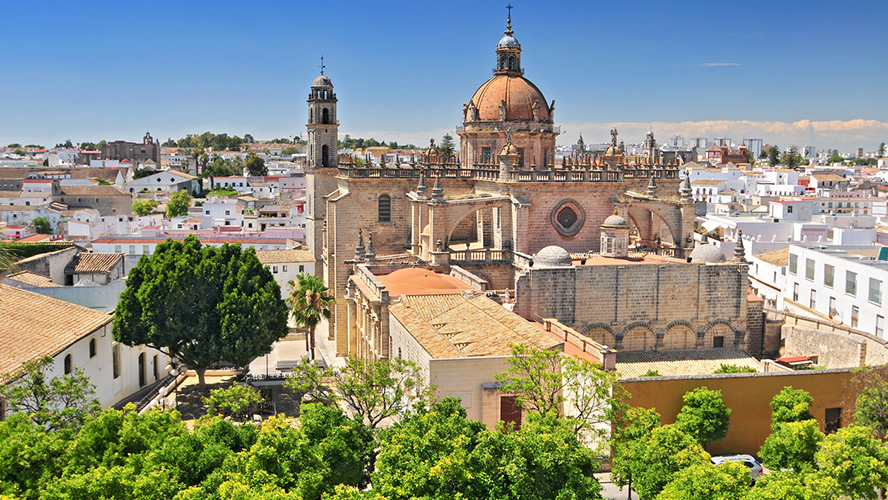
Gibraltar
Gibraltar, also known as the Rock, is connected to La Línea de la Concepción in Cadiz. Although Gibraltar has always been famous for duty-free shopping, there are plenty of other activities to enjoy here on a day trip.
Gibraltar can be reached by car or foot; make sure you have your documents in order because you have to pass Spanish and British checkpoints. Once you’ve crossed the border, we recommend starting your visit with the cable car that takes you to the top platforms of the Rock for amazing views. Macaques, a species of monkey, roam free here so watch out that they don’t steal your belongings! If you’re interested in history, don’t miss a tour of the Great Siege Tunnels and the WW2 tunnel.
Once you’ve returned to the lower part of Gibraltar, other great places to visit include La Alameda Gardens, the English cemetery, Main Street, the biggest shopping street, and lively Casemates Square. If you have time to spare, you can also go for a dip off one of the beaches. The most picturesque is Catalan Bay, a small bay with colourful houses.
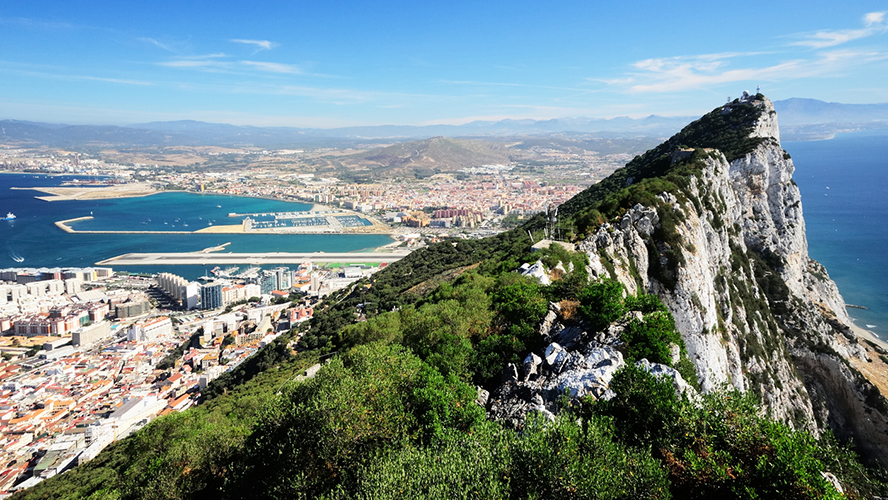
Sanlúcar de Barrameda
Beautiful Sanlúcar de Barrameda is often visited to reach Doñana National Park, but it’s also worth spending a full morning in its historic centre. Essential stops include the castle of Santiago, the church of Nuestra Señora de la O, the palace of Orleans-Borbón (the summer residence of the dukes of Montpensier) and the palace of Medina Sidonia. It would also be a crime to miss out on a tour of Bodegas Barbadillo, the biggest producer of manzanilla in Cadiz province. Make sure you book a guided tour in advance to find out all about this local wine.
You might have heard about the horse races on the beach, and if you’d like to see the improvised race track, head to La Calzada and Las Piletas beaches – if you’re in town in August, you can even watch a race. Other beaches worth visiting include La Jara, Bajo de Guía and Bonanza (next to the salt mine).
And, of course, don’t forget to visit Doñana Park and its surprising landscapes, fauna and flora.
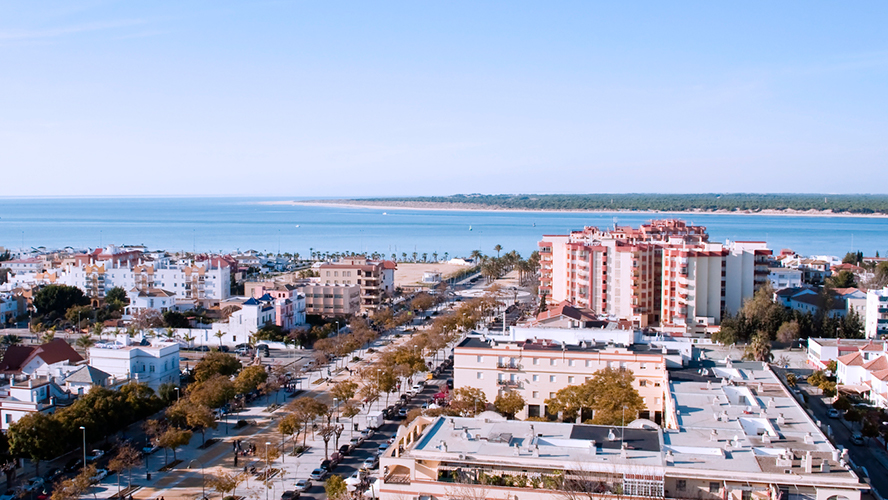
Zahara de los Atunes
Zahara de los Atunes has been a fashionable spot on the Cadiz coast for several years and it can instantly be noticed by the large number of tourist-orientated bars, restaurants and terraces that have proliferated along the town’s few streets. Although the surrounding area is packed with urban developments, the town itself still conserves the essence that made it famous and we firmly hope that it doesn’t lose its authentic spirit.
What is there to do in Zahara de los Atunes? Relax without looking at your watch, and enjoy its golden sand beach, blue sea and wonderful restaurants. Atlanterra, Agua de Enmedio and Cala de los Alemanes beaches are along the same stretch of coastline in Tarifa municipality.
If you’d like to do a trip, you could visit Camarinal Lighthouse or head to Barbate to hike the Ruta de los Acantilados in Parque de la Breña, which is a great experience.
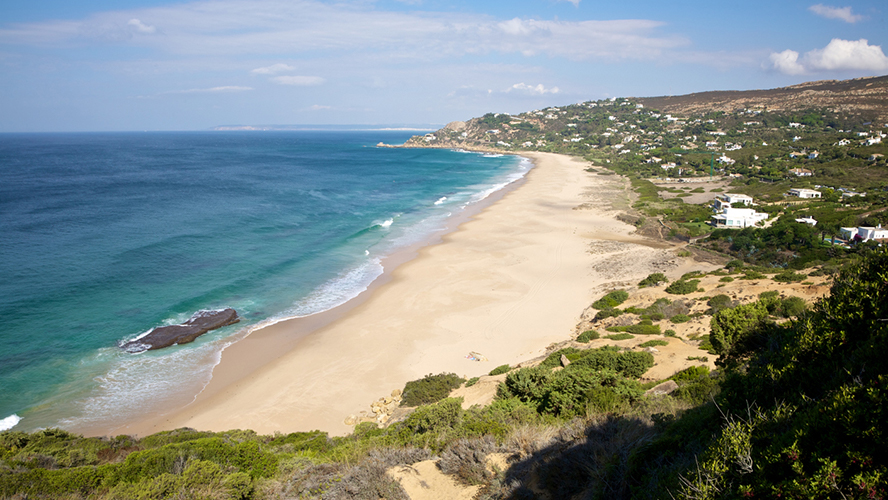
Tarifa
The ‘city of wind’ hardly needs an introduction: Tarifa is already famous around the world as a mecca for windsurfing lovers, and more and more visitors come here every year, drawn by its perfect kitesurfing and windsurfing conditions.
When you’re tired of doing sport, make sure you visit the town to discover its lovely architecture. The most important building is the castle of Guzmán el Bueno, a 10th century fortress that was built on the orders of Abderraman III, the caliph of Cordoba. Visiting the interior is extremely worthwhile to admire the layout and enjoy wonderful views over the rooftops of Tarifa. Other places of interest include the church of San Mateo, Jerez Gate and the municipal market, which is full of great produce.
Nature lovers should also make time in their schedule for some day trips, such as a whale watching excursion or hiking in El Estrecho Natural Park. And don’t forget beaches such as Valdevaqueros, Los Lances and Punta Paloma. Beautiful Bolonia beach is a little further away, and is next to the Roman city of Baelo Claudia, another essential stop.
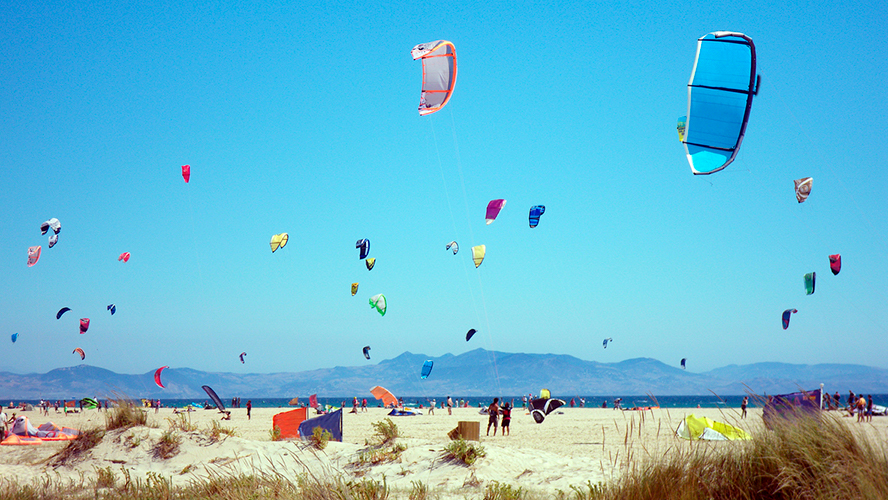
Vejer de la Frontera
Set atop a hill, Vejer de la Frontera has white-washed houses decorated with flowers, the remains of an ancient wall and a zig-zagging maze of streets, so it’s easy to understand why it convinced the “Most Beautiful Towns in Spain” association to include it on its list.
The best way to visit Vejer is to simply wander the streets as your fancy takes you, because you’ll always find beautiful churches, convents, flower-filled courtyards and stately mansions to admire.
Don’t miss the windmills in San Miguel neighbourhood; the natural pools of Santa Lucía (before you climb the hill) and the sanctuary of Nuestra Señora de la Oliva, which is also outside the town.
Food lovers should pay a visit to San Francisco market, where you can both buy produce and enjoy its gourmet side. And if you’re beach fans, you’ll love El Palmar, a lively spot with great restaurants.
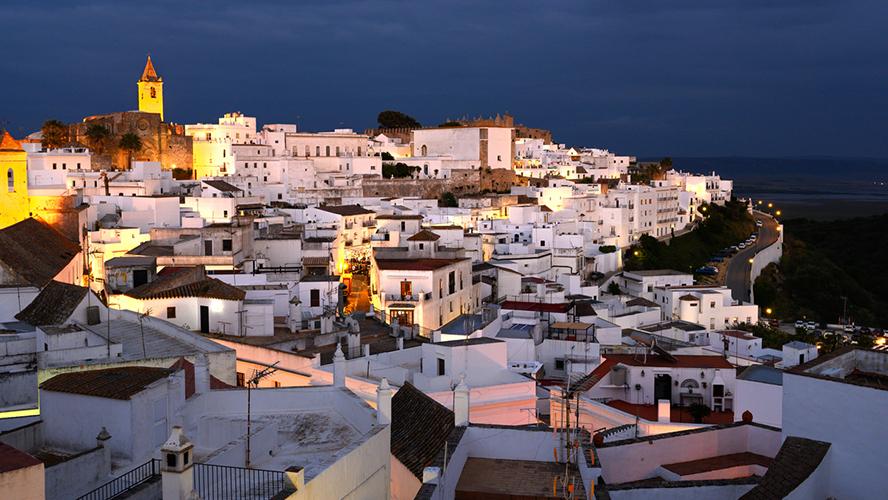
Chipiona
Located between Sanlúcar de Barrameda and Rota, Chipiona is famous for being the birthplace of Rocío Jurado, one of Spain’s most famous singers, and the town has lots to offer visitors. Travellers are drawn here in the summer thanks to its beautiful beaches, especially Regla beach, which often has blue flag status. Others are also worth exploring, such as Tres Piedras, Camarón and Cruz del Mar beaches.
As well as having fun by the sea in Chipiona, it’s also worth visiting its famous lighthouse, the tallest in Spain, at the start of the Guadalquivir Estuary.
Don’t miss the castle of Chipiona, today an interpretation centre, and the Moscatel Museum, which is a great way to discover this famous local wine. Great restaurant recommendations include Gastrotasca Sin Bulli and Ajedrez.
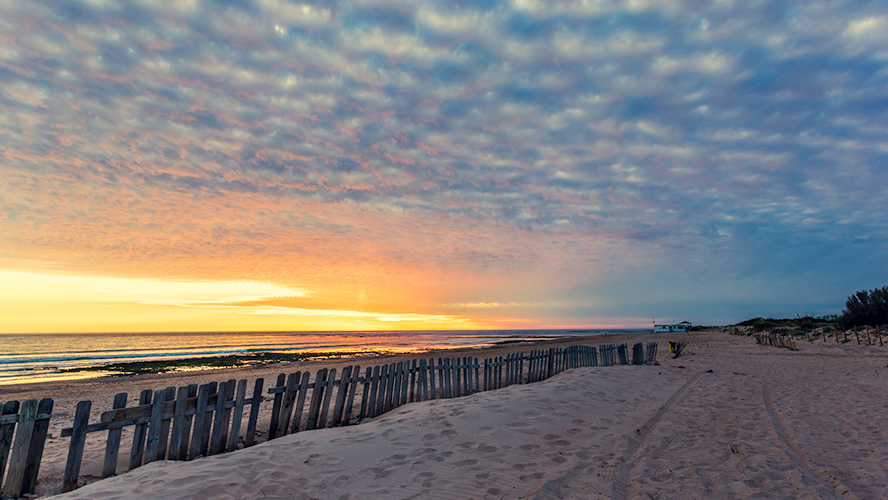
Conil de la Frontera
Conil de la Frontera is one the most popular tourist destinations on the Cadiz coastline and it has a great infrastructure for visitors, with restaurants taking centre stage. While the historic centre is home to treats such as the lovely Pescadores neighbourhood, several house-palaces, Guzmán Tower and a number of churches, its beaches are the main attraction and bring more tourists here every year. Conil has over 15 km of coastline with wide beaches and tiny coves.
Various themed food events are held in Conil throughout the year and are based around local produce such as vegetables and red tuna, with participation by the town’s numerous restaurants. These events are a great excuse to discover this friendly town of white-washed houses.
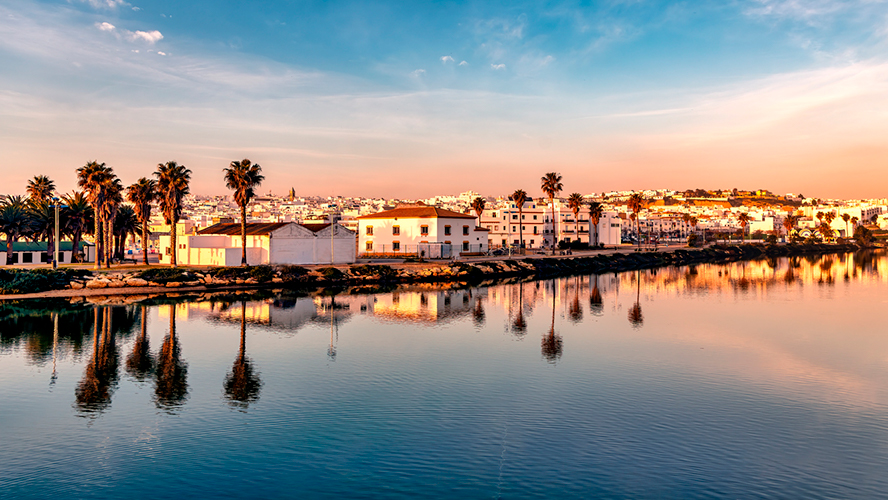
THE MOST BEAUTIFUL BEACHES IN CADIZ
Bolonia beach
This unspoilt beach with no beach bars frequently appears on lists of the most beautiful beaches in Spain. It has golden sand and crystal-clear waters that are much-loved by swimmers. Bolonia’s most distinctive feature is the giant dune that rises up at one end, which has been made a Natural Monument. As well as climbing the dune, make time to visit the Roman ruins of Baelo Claudia, just in front of the beach. There is also a wooden walkway for easy access to a nearby area of pine trees.
If you come here in low season, don’t be surprised if you see cows wandering along the beach. But don’t worry, they’re harmless!
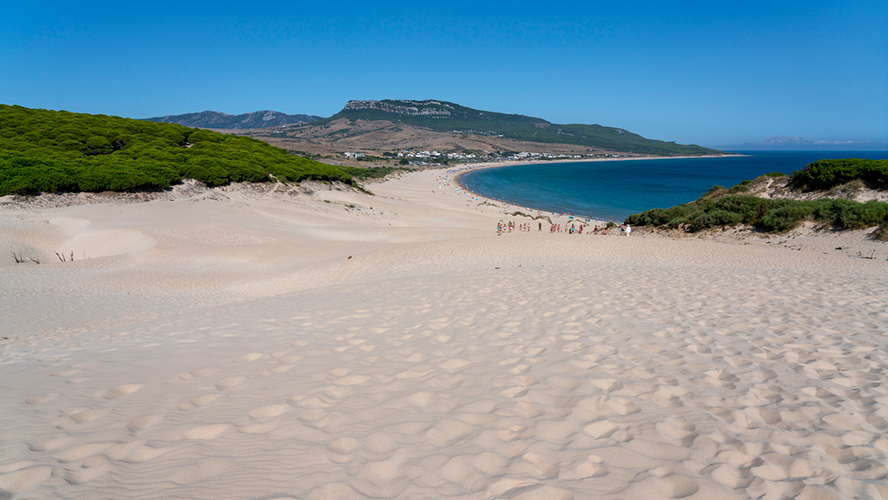
El Palmar beach
El Palmar is just over 4 km long and almost 100 m wide and has become a fashionable spot along the Cadiz coastline in recent years. Its white sand, easy access via walkways and countless leisure and dining options have meant plenty of travellers have added it to their favourites list. Sunsets from this beach, part of Vejer municipality, are amazing and are only matched by the quality of its restaurants. Walking, surfing (there are lots of surf schools right by the beach), a sunset horse ride and night-time partying are all good reasons to choose El Palmar for your next holiday.
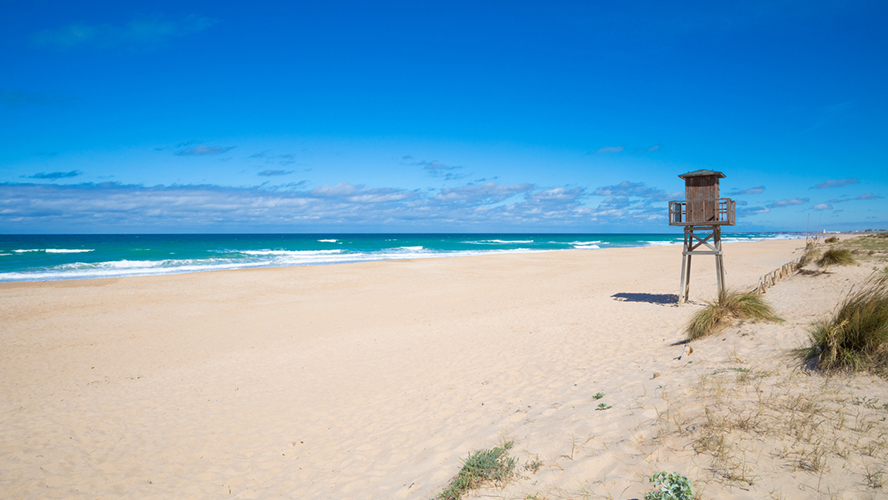
Caños de Meca
Caños de Meca beach, under the watchful gaze of Trafalgar Lighthouse, never goes out of fashion and it’s held a leading position among the top beaches in Cadiz for decades. It’s wild appearance, moving dunes with half-buried pine trees and large number of restaurants and leisure options attract a faithful crowd here year after year.
It gets pretty crowded on high season weekends, but the rest of the year offers visitors a unique experience and the chance to get in touch with nature. It also has several areas for nudism.
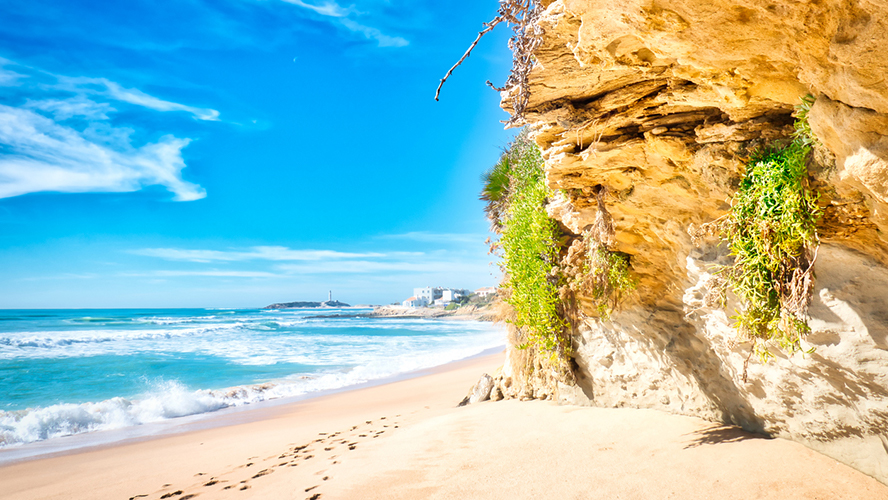
Punta Paloma
Punta Paloma is one of the easiest to identify beaches in Tarifa municipality because its giant dune and masses of kitesurf kites can be spotted from miles away. It’s next to famous Valdevaqueros beach, another favourite among water sports fans.
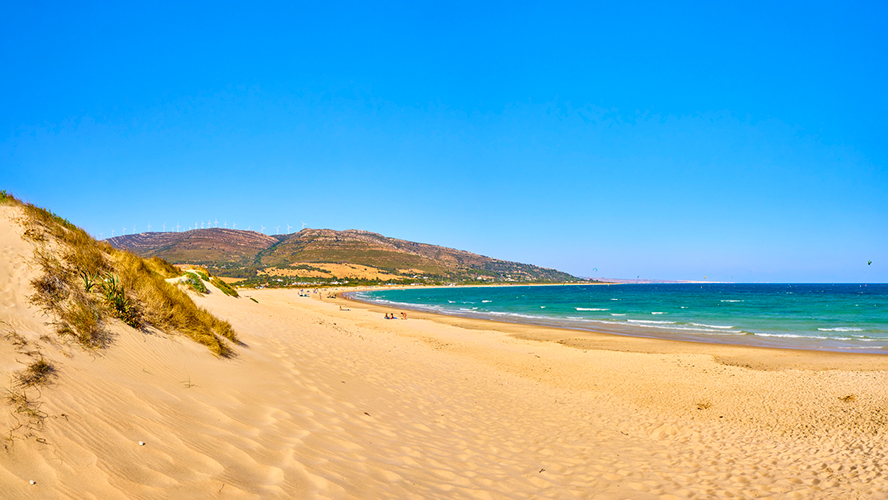
Other beaches and places to visit in Cadiz
Cadiz’s beaches are typically wide, covered in golden sand and have cold water – don’t forget that this coastline is on the Atlantic Ocean. In addition to the beaches mentioned above, other spots worth visiting include La Barrosa in Chiclana; Bateles and Fontanilla in Conil; and beautiful Hierbabuena beach in Barbate.
La Barrosa beach
This is the big beach in Chiclana and one of the most famous tourist destinations in Cadiz. It’s 8 km long and over 100 m wide, and lies between Conil and the cliffs of Sancti Petri. The beach has fine, golden sand and is fairly shallow with moderate waves. It is also more sheltered from the levant, a strong easterly wind, than other areas of Cadiz such as Tarifa or Zahara. La Barrosa often features on lists of the best beaches in Spain; it has blue flag status and other quality certificates.
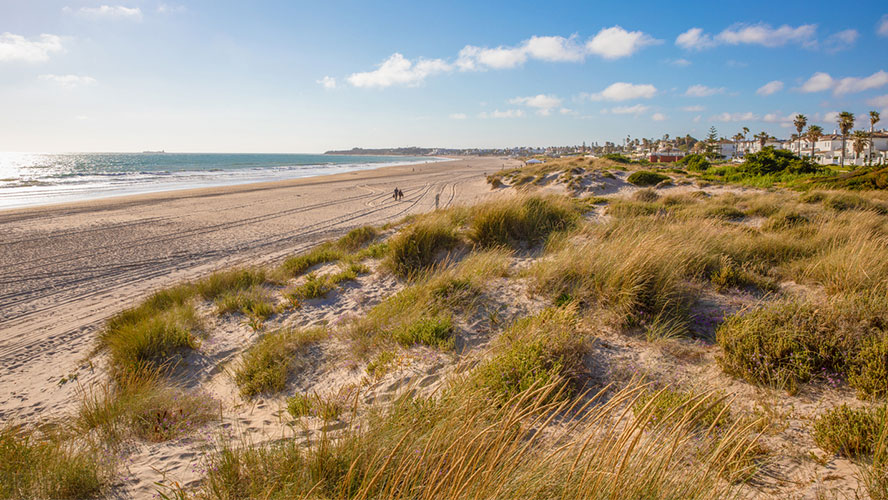
Los Bateles beach
Los Bateles is opposite Conil de la Frontera and is 850 m long and 130 m wide. It’s the busiest in town because it’s so close, easy to reach and has great facilities with lifeguards and beach bars. The Salado River runs into the sea here and windsurfing and kitesurfing are popular. The sand is fine and golden and waves here are moderate in size.
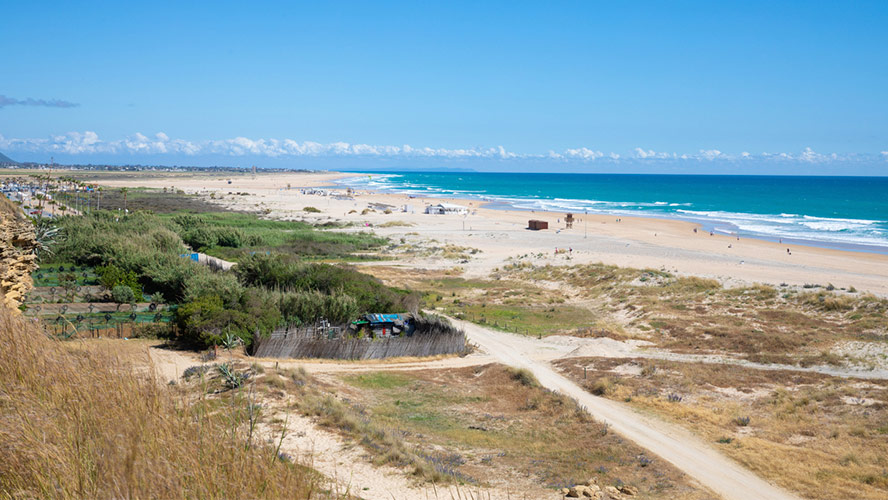
La Fontanilla beach
One of the best loved beaches in Conil thanks to its excellent facilities, fine, golden sand and shallow, calm waters. The best restaurants in Conil are found here and in summer there are three beach bars on the same stretch of beach. There are also showers, toilets, lifeguards and a car park. It’s the perfect place for running, going for a walk, doing water sports, fishing or simply sunbathing.
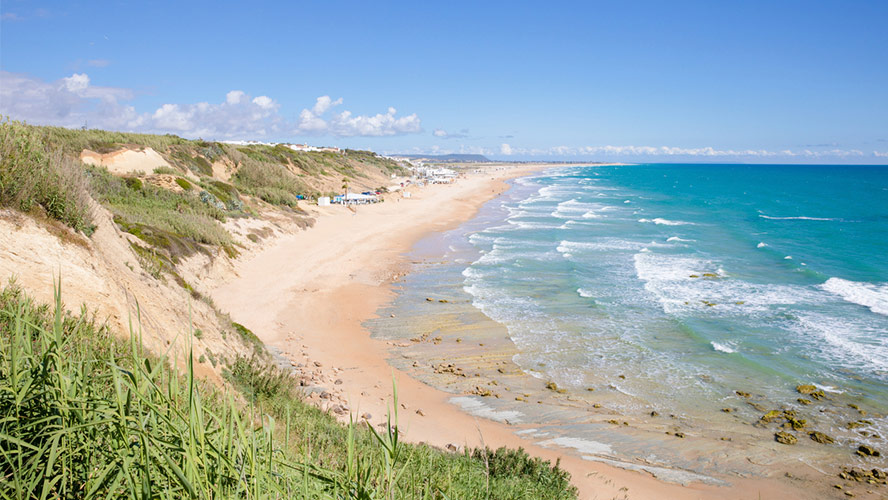
La Hierbabuena beach
Located between Barbate port and Los Caños de Meca, right at the foot of La Breña y Marismas de Barbate Natural park, this beach is also known as El Chorro because water flows down from the nearby cliffs. It’s around one kilometre long and is one of the least known beaches in Cadiz. This practically unspoilt beach has fine, golden sand and is surrounded by a pine forest, making it even more beautiful.
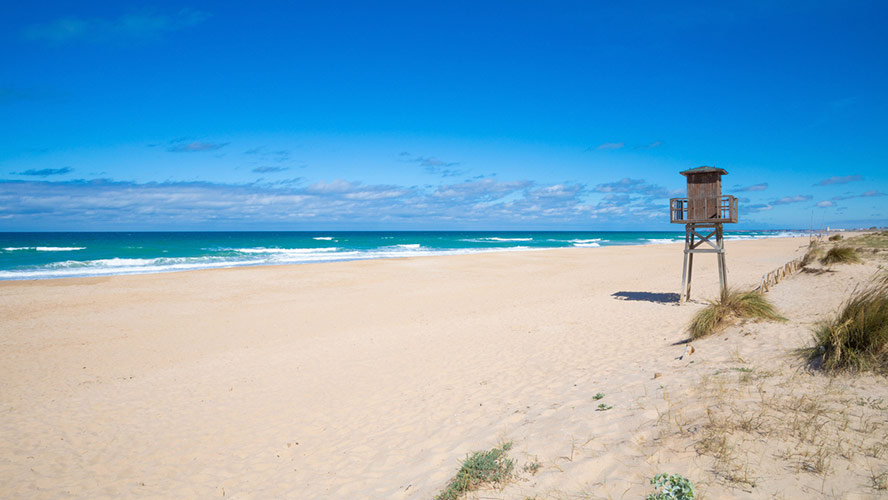
Where to stay in Cadiz
If you’re holidaying in Cadiz province, it’s worth choosing great accommodation where you can enjoy all the comforts of a hotel and easily travel around the province to discover its many charms. Starting with the city of Cadiz, the provincial capital, the Occidental Cádiz has all the advantages of a city hotel but is just five minutes from the beach. It’s definitely the perfect option all year round. Heading down the coastline, the Royal Hideaway Sancti Petri in Chiclana is a five-star hotel with the largest wellness centre in Andalusia. You could also choose the Novo Resort The Residence Luxury Apartments by Barceló (in Novo Sancti Petri, Chiclana), which has all the advantages of staying in an apartment (it has 91 luxury apartments and penthouses) with the comfort of a hotel.
If you’re travelling without children, the Barceló Conil Playa-Adults only is the perfect place to stay: it defines the word ‘peace’ and has wonderful sunsets. Next is the Barceló Costa Ballena Golf & Spa, a great destination for golf fans and wellbeing lovers. It’s on Costa Ballena, between Rota and Chipiona.
Heading inland, you’ll find the Barceló Jerez Montecastillo & Convention Center and the Barceló Montecastillo Golf in a peaceful setting with multiple attractions for golf enthusiasts.
























































